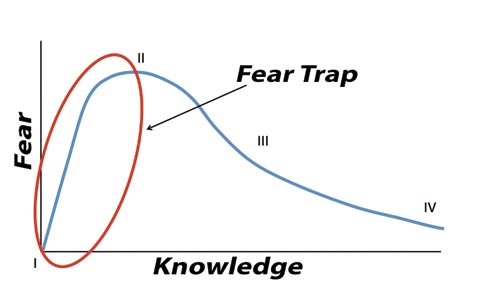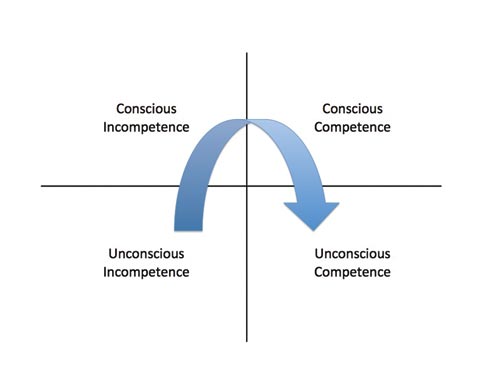Double Your Mistake Rate
Richard Pierce Thomas
Leadership and Small Business Consultant
This is what you are up against,” I explained to the uber-young leadership team pointing to a diagram on organizational learning. “This is called the Fear Trap, and you are right in the middle of it,” I said, tapping my forefinger on the origin of the curve.
I was facilitating a two-day offsite for a software startup that my friend Linda had pleaded for my help on. Describing to the team my take on Maslow’s Conscious Competence Learning Model, I had first illustrated his graph as follows:
 Stage I – Unconscious Incompetence: The individual does not know how to do something and does not necessarily recognize the deficit.
Stage I – Unconscious Incompetence: The individual does not know how to do something and does not necessarily recognize the deficit.
Stage II – Conscious Incompetence: Though the individual does not understand or know how to do something, he or she does recognize the deficit, as well as the value of a new skill in addressing the deficit. The making of mistakes can be integral to the learning process at this stage.
 Stage III – Conscious Competence: The individual understands or knows how to do something. However, demonstrating the skill or knowledge requires concentration. It may be broken down into steps, and there is heavy conscious involvement in executing the new skill.
Stage III – Conscious Competence: The individual understands or knows how to do something. However, demonstrating the skill or knowledge requires concentration. It may be broken down into steps, and there is heavy conscious involvement in executing the new skill.
Stage IV – Unconscious Competence: The individual has had so much practice with a skill that it has become “second nature” and can be performed easily. As a result, the skill can be performed while executing another task. The individual may be able to teach it to others, depending upon how and when it was learned.
Once the team grasped the concept behind Maslow’s model, I illustrated the next one, based on my own theory. I call it the Fear Curve and have found it most apparent in leaders who are running businesses. While the progression of stages from Maslow’s model take place along the x-axis resulting in knowledge, the y-axis is represented by the primary emotion that is experienced when it comes to change: fear.
In the Fear Curve, the stages of learning are described as follows:
I – You stink at what you do, and you don’t know it.
II – You stink at what you do, and you now know it.
III – You are finally getting it, and seeing results.
IV – You rock, and you don’t even think about it.
Think Michael Jordan in game 5 of the 1997 NBA finals against the Utah Jazz. Known commonly as The Flu Game, Jordan managed to score 38 points to win the game, all while suffering from the flu. Unconscious competence at its prime!
Similarly in business, as our awareness increases as to how much we really don’t know about running an organization and leading a team, our fear increases proportionally to our awareness until we either figure it out, or we run the other way because we can’t take the heat anymore. While running away provides temporary relief, it also keeps us stuck in the Fear Trap – continually cycling back and forth between Unconscious Incompetence and Conscious Incompetence, hoping that something will eventually change but ultimately never doing anything differently. You’ve heard that definition before, right? (aka, definition of insanity…).
“How do we get out of the Fear Trap?” one of the team asked.
Circling the Fear Trap in red, I continued. “Right now, you are somewhere in this trap. You’ve got to fight through it, because the fear stymies you into doing nothing. In my book, that is way worse than the risk of making a wrong one.”
“So you are saying we should keep making wrongs decisions until we get it right?”
“Given the choice of being afraid to make a decision, or the risk of making a wrong one, yes, I’d take the risk every time. At least that way you’ll learn from it and hopefully not repeat it again. With a little luck and some smarts, you’ll make enough good ones to survive the learning process and be all the wiser for it in the long run.”
If you find yourself stuck on decision-making, you are likely caught in the Fear Trap. If you want to propel your leadership forward, be prepared to increase your mistake rate. I am confident you’ll be surprised by the results.
Rick P. Thomas is President of Activate Leadership, a leadership development consultancy in Washington state. He consults and speaks to organizations across the country, focusing on individual and organizational achievement.